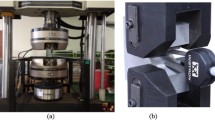Abstract
Knowledge of the fracture and fatigue behaviour of metallic alloys at extreme environmental temperature conditions is required to assess the safety of structural components operating in particular fields: aero-spatial, off-shore structures, power plants superconductors, polar Antarctic facilities, etc. Among the structural metallic alloys for civil, mechanical engineering and plant applications, steel S275 J2 is widely used, whereas aluminium alloys such as Al7075 T6 are significant especially for aero-spatial and polar Antarctic applications. In this paper, the main experimental mechanical characteristics of such metallic materials at room temperature as well as at low temperatures are examined. Three temperatures are considered: 293 K (+20 °C, room temperature RT), 243 K (−30 °C) and 193 K (−80 °C). The corresponding values of fracture toughness and endurance limit available in the literature are reported herein. Further, experimental tests have been performed to determine the unavailable mechanical properties. Then, the values of such fracture and fatigue parameters at various temperatures are critically discussed.





Similar content being viewed by others
Abbreviations
- a :
-
Mean value of crack length during the test
- A :
-
Cross-sectional area of the specimen
- Al 7075 T6:
-
High-strength aluminium alloy
- b,c :
-
Material’s constants in Peterson and Neuber relations for notch sensitivity, respectively
- CG:
-
Crack growth
- °C:
-
Temperature (Celsius)
- D :
-
Specimen diameter
- E :
-
Young modulus of the material
- F max :
-
Maximum value of the applied load
- K :
-
Absolute temperature (Kelvin)
- KIC, KIC(T):
-
Fracture toughness at room temperature and at temperature T, respectively
- K I, max :
-
Stress-intensity factor at the maximum value of the applied load
- K t , K f :
-
Stress concentration factor and fatigue strength reduction factor, respectively
- N :
-
Number of loading cycles
- NDT:
-
Nil ductility transition
- PQ, Pmax :
-
Applied loads defined according to ASTM B645-02
- q = (Kf − 1)/(Kt − 1):
-
Notch sensitivity factor of the material
- r :
-
Notch root radius
- R :
-
Loading ratio
- R p0.2 :
-
0.2% deformation difference with respect to proportionality stress level
- RT:
-
Room temperature
- S275 J2:
-
Structural carbon steel
- T DBT :
-
Temperature at which the ductile-brittle transition occurs
- T NDT :
-
Temperature above which a metal exhibits ductile behaviour
- W :
-
Specimen width
- α[°C−1]:
-
Thermal expansion coefficient of the material
- σ f :
-
Endurance limit
- σmax, σm :
-
Maximum and mean value of the applied stress during a cycle
- σy, σu :
-
Yield stress and ultimate stress of the material
- ν :
-
Poisson ratio of the material
References
Liaw PK, Logsdon WA (1984) Eng Fract Mech 22:585. doi:https://doi.org/10.1016/0013-7944(85)90122-5
Lü B, Zheng X (1991) Mater Sci Eng 148A:179
Zheng XL, Lü BT (1984) In: Carpinteri A (ed) Handbook of fatigue crack propagation in metallic structures. Elsevier Science B.V., p 1385
Lü B, Zheng X (1992) Eng Fract Mech 42:1001. doi:https://doi.org/10.1016/0013-7944(92)90139-6
Carpinteri A (ed) (1984) Handbook of fatigue crack propagation in metallic structures. Elsevier Science B.V
Gasqueres C, Sarrazin-Baudoux C, Petit J, Dumont D (2005) Scr Mater 53:1333. doi:https://doi.org/10.1016/j.scriptamat.2005.08.036
EN 10025-2 (2005) Hot rolled products of structural steels—part 2: technical delivery conditions for non-alloy structural steels
Wigley DA (1971) Mechanical properties of materials at low temperatures. Plenum Press
Reed RP, Clark AF (1983) Materials at low temperatures. American Society for Metals
Sindelar RL, Lam PS, Caskey GR Jr, Woo LY (1999) Mechanical properties for fracture analysis of mild steel storage tanks. WSRC-MS-99-00215
Haggag FM, Phillips LD (2004) In: Proceedings of IPC 2004 International Pipeline Conference. Calgary, Alberta, Canada, October 4–8, 2004
Ritchie RO, Knob JF, Rice JR (1973) J Mech Phys Solids 21:395. doi:https://doi.org/10.1016/0022-5096(73)90008-2
Michael HC, Seward SK (1988) A compendium of sources of fracture toughness and fatigue crack growth data for metallic alloys—part III. NASA Technical Memorandum 100675, Langley Research Centre, Hampton, Virginia
ASTM B 645-02. Practice for plane-strain fracture toughness testing of aluminium alloys
Databook on fatigue strength of metallic materials, vol. 2. The Society of Material Science, Japan; 1996
Peterson RE (1959) In: Sines G, Waisman JL (eds) Metal fatigue. McGraw-Hill, New York, p 293
Neuber H (1958) Theory of notch stresses. Springer
ASTM E466-96 (2002) Standard practice for conducting force controlled constant amplitude axial fatigue tests of metallic materials
ASM handbook (1996) Fatigue and fracture. American Society of Metals; 19, USA
Military handbook, MIL-HDBK-5A
Waterman & Ashby, Elsevier materials selector. Elsevier, 1991
ASTM E399-90: standard test method for plane strain fracture toughness of metallic materials; 1990
Kiefer TF, Keys RD, Schwartzberg FR (1965) Determination of low-temperature fatigue properties of structural metal alloys. Martin-Marietta Corporation, National Aeronautics and Space Administration, Huntsville, Alabama
Ransom JS (1955) A guide to statistical methods for use in fatigue testing. In: Colloqium on Fatigue, IUTAM
Acknowledgements
The authors gratefully acknowledge the research support for this work provided by the Italian Ministry for University and Technological and Scientific Research (MIUR) and the Italian National Research Council (CNR). Further, the authors gratefully acknowledge the valuable cooperation of Dr. D. Magagnini by RTM Breda srl, V. Po 84, 20032 Cormano, Milan, Italy.
Author information
Authors and Affiliations
Corresponding author
Rights and permissions
About this article
Cite this article
Carpinteri, A., Brighenti, R. Fracture and fatigue properties of metallic alloys S275 J2 and Al7075 T6 at low temperatures. J Mater Sci 43, 4780–4788 (2008). https://doi.org/10.1007/s10853-008-2675-1
Received:
Accepted:
Published:
Issue Date:
DOI: https://doi.org/10.1007/s10853-008-2675-1




